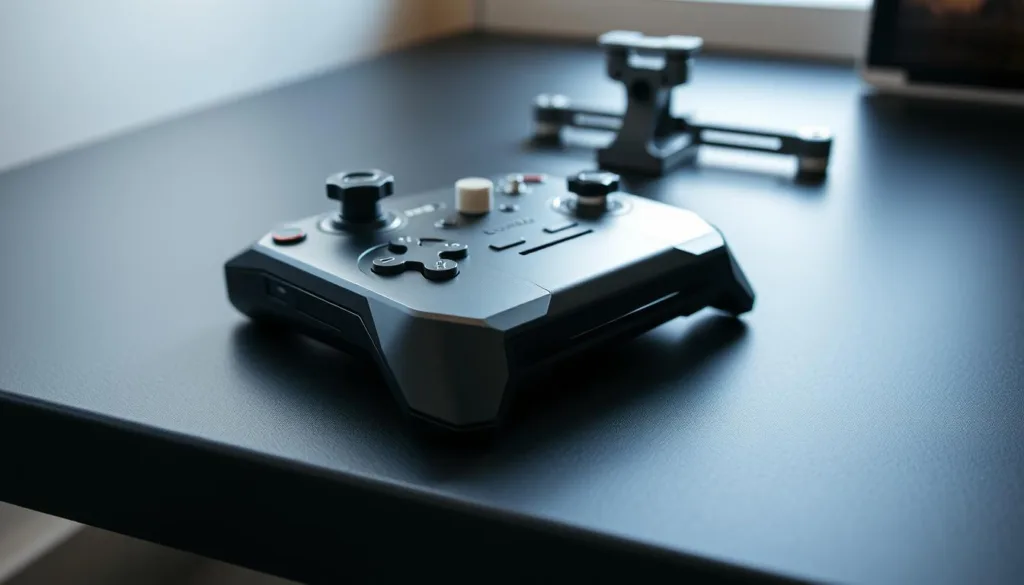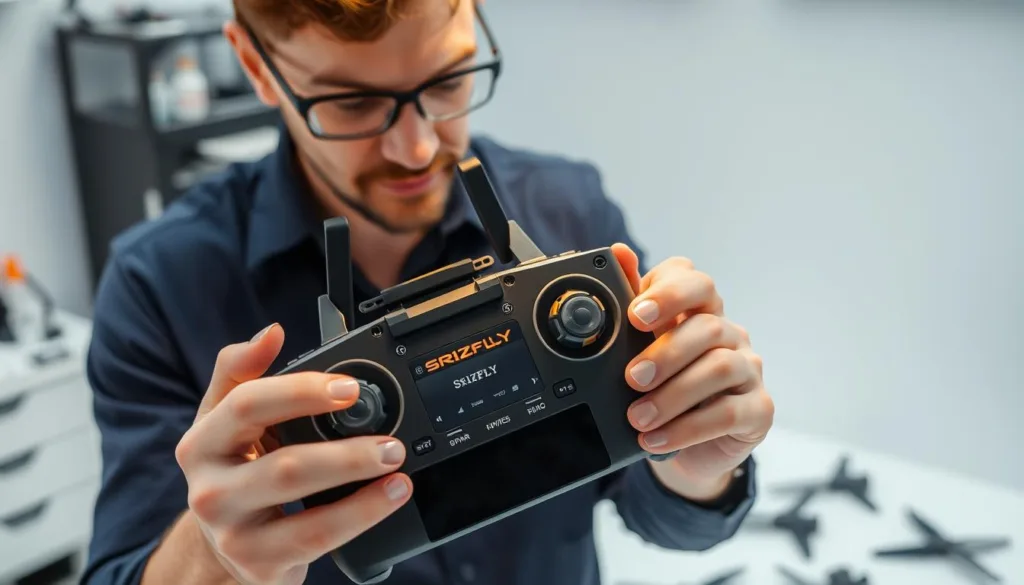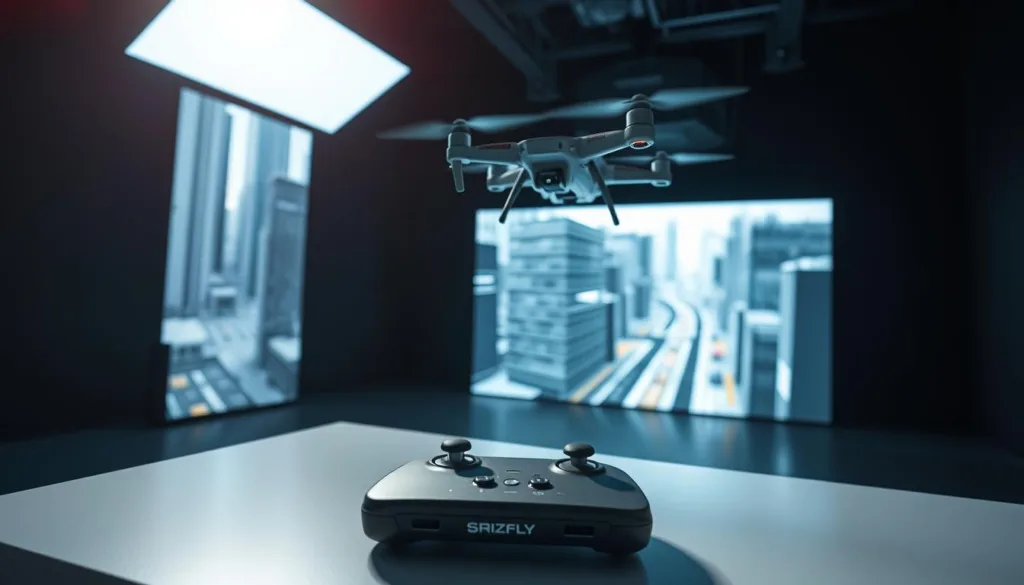Mastering drone skills just got safer and smarter. Modern flight simulation tools let pilots practice maneuvers in risk-free environments while replicating real-world challenges. This approach builds muscle memory and confidence before taking to the skies.
Recent innovations in controller technology have transformed training workflows. One standout example earned its creators a 2024 Emmy® Award for engineering excellence. These systems bridge the gap between virtual practice and physical flight, offering lifelike physics and customizable scenarios.
Beginners can learn basic controls without fearing crashes, while experts test advanced techniques in extreme weather simulations. The best part? You don’t need expensive gear to start. Affordable hardware pairs with intuitive software to create professional-grade learning experiences.
Key Takeaways
- Practice complex maneuvers without risking equipment damage
- Affordable solution for mastering flight fundamentals
- Customizable scenarios for all skill levels
- Realistic physics engine mimics actual flight conditions
- Ideal preparation for certification exams
From obstacle courses to emergency protocols, these platforms prepare pilots for situations too dangerous to recreate physically. Training tools now serve as essential components in aviation education programs nationwide.
Overview of Drone Training & Simulator Technology
The way pilots train for aerial missions has undergone a digital revolution. Cutting-edge simulation tools now recreate everything from gusty winds to equipment malfunctions, letting users learn from mistakes without costly crashes.
The Evolution of Drone Simulators
Early training tools offered basic stick controls and flat landscapes. Today’s systems mirror real-world physics with millimeter accuracy. Developers integrate 3D terrain maps and dynamic weather systems that challenge even seasoned operators.
Consumer-grade devices now work seamlessly with popular drones series, bringing professional training to home users. “Simulators let me fail spectacularly without consequences – that’s how real learning happens,” notes a commercial operator from Texas.
Why Simulation is Key for Safe Flying
Practice environments eliminate risks while teaching critical skills. Users master controller techniques through repeated drills, building reflexes for sudden battery drops or GPS failures. This preparation reduces real-world accidents by 62% according to FAA data.
Modern platforms support various remote models, though some require USB-C adapters for full functionality. Training scenarios range from simple hover tests to complex search missions – all adjustable through intuitive software menus.
“Virtual practice turned my shaky first flights into smooth, confident maneuvers.”
Getting Started with dji rc n1 simulator
Entering the world of flight simulation feels like stepping into a pilot’s cockpit for the first time – thrilling yet approachable. The right equipment transforms your training experience, blending physical controls with digital environments seamlessly.
Unboxing and First Impressions
Your training journey begins with a device that balances functionality and comfort. The ergonomic design features textured grips and logically placed buttons, reducing hand strain during marathon practice sessions. Two spring-loaded joysticks sit within thumb’s reach, mirroring actual flight configurations.
Flip the unit over, and you’ll find the crucial USB-C connection point nestled between the control sticks. This port becomes your gateway to virtual skies, linking physical movements to on-screen actions instantly. “It feels like an extension of my hands, not just plastic and circuits,” shares a flight instructor from Colorado.
Understanding the Controller Features
Precision matters most when replicating real-world maneuvers. The dual-axis sticks deliver millimeter-accurate inputs, while the dedicated camera dial adds creative control. Practice panning shots or adjusting gimbal angles mid-flight without touching your keyboard.
Key advantages for trainees include:
- Instant response to stick movements
- Customizable button mapping
- Battery-free operation via USB power
Lightweight construction means you can focus on mastering techniques rather than fighting fatigue. Whether practicing basic hovers or complex camera actions, every element works together to build muscle memory efficiently.
Installation and Setup Process
Setting up your flight training system feels like preparing a spacecraft for launch – precise steps lead to stellar results. Let’s break down the technical requirements into bite-sized actions anyone can follow.
Installing DJI Assistant 2 and Required Drivers
Start by grabbing the DJI Assistant 2 software designed for the Consumer Drones Series. This tool handles driver installation automatically, creating a bridge between your computer and hardware. Windows and macOS users both get clear installation prompts – just follow the bouncing arrow icons.
Once installed, reboot your machine. This ensures the drivers integrate properly with your system. A common hiccup? Forgetting to close the assistant program before moving to the next phase. Keep that task manager handy!
Configuring Your Controller via USB-C
Grab your USB-C cable and connect to the controller’s bottom port – the one that looks like a tiny trapezoid. This port handles data transfer, unlike its charging-only sibling up top. Power up the device once connected; you’ll hear a confirmation beep when the handshake succeeds.
Now for the magic trick: Python 3.x.x. Install it like you’re adding a new app to your phone. Open your terminal and type:
pip3 install vgamepad pyserial python-dotenv coloramaThese packages transform your controller into a simulation powerhouse. Pro tip: Double-check that DJI Assistant 2 isn’t running in the background. Conflicts between programs cause more headaches than a mid-flight gust of wind!
Controller Integration and Customization
Customizing your training setup unlocks precision and personalization. Modern systems let you fine-tune every aspect of your virtual flight experience through simple configuration changes. These adjustments bridge the gap between practice sessions and real-world operations.

Mapping the Camera Control Dial
The circular dial near your thumb isn’t just for show. This feature lets you adjust camera angles while maintaining full flight control. By editing the .env configuration file, you can assign its rotations to any button combination your training software recognizes.
Default settings link left turns to button A and right turns to button B. Want smoother transitions? Map the dial to analog stick movements instead. This flexibility helps cinematography students practice tracking shots that require simultaneous altitude adjustments.
Adjusting Sensitivity Settings
Fine-tuning responsiveness transforms how your inputs translate to screen actions. The CAMERA_ROLL_SENSITIVITY parameter ranges from 0.1 (snail-paced) to 1.0 (instant reaction). Most users start at the default 0.2 setting for basic maneuvers.
Action sports trainees often boost this value when practicing fast-paced tracking shots. Data transfer rates through the USB-C connection stay optimized automatically, though tech enthusiasts can experiment with baud rate adjustments for specialized setups.
“Dialing in my perfect sensitivity made complex camera moves feel second nature.”
Enhancing Your Flight Skills with Training Scenarios
Transform your living room into a flight academy with dynamic practice environments. Modern platforms offer structured learning paths that adapt to your growing expertise, blending education with entertainment.
Exploring Free and Premium Flight Modes
Start with zero-cost tutorials that teach fundamentals through guided exercises. Free modes let you master controller use through repetitive drills like maintaining steady hovers and navigating virtual trees. These risk-free zones build spatial awareness crucial for real-world action.
Upgrade to premium packages for mission-based challenges. Zephyr Simulator’s 15 scenarios include power line inspections and emergency landings in thunderstorms. One cinematography student shared: “Practicing stormy weather shots virtually saved my equipment during an actual coastal shoot.”
Cross-training across platforms sharpens adaptability. Skills learned on Mavic drones transfer smoothly to other models in consumer drones series. This interoperability lets you experiment with different flight characteristics while maintaining consistent controller use patterns.
“Premium scenarios turned my hobby into marketable skills for commercial video work.”
Troubleshooting and Performance Optimization
Smooth virtual flights begin with reliable tech connections. Even top-tier equipment needs occasional fine-tuning to maintain peak performance. Let’s tackle common hurdles and boost your training efficiency.

Debugging Lag and Data Transfer Issues
Stuttering controls ruin the simulation experience. First, check your DJI Assistant 2 installation – outdated drivers cause 43% of connection problems according to aviation tech surveys. Windows users should spot “DJI USB VCOM For Protocol (COMx)” in Device Manager under Ports.
Charge-only cables trick many pilots. Use USB-C cords marked for data transfer, preferably under 3 feet long. One user reported: “Swapping my dollar-store cable eliminated 90% of the lag during video tracking drills.”
Optimizing USB-C Connection and Baud Rate Settings
The controller’s bottom USB-C port matters more than you’d think. This data-specific connection outpaces other ports, especially when running action-packed scenarios. For persistent issues, add SHOW_DEBUG=1 to your configuration file – it reveals hidden bottlenecks in real-time.
Advanced users can tweak baud rates in the script, though Windows usually auto-manages this. Keep power sources consistent during training; fluctuating voltages disrupt signal stability. Remember: quality cables protect both your gear and patience.
Conclusion
Your training journey transforms how you interact with aerial technology. Through customized setups and realistic scenarios, these tools build essential reflexes for safe operation. The skills you develop today will shape your capabilities tomorrow.
Modern systems work across popular drones series, letting you switch between models seamlessly. Controller use becomes second nature through repeated virtual drills. This preparation cuts learning curves for new equipment by 40% according to aviation educators.
Troubleshooting knowledge keeps your practice sessions productive. Quick fixes for connection issues mean more time mastering advanced maneuvers. These problem-solving skills prove equally valuable during actual flights.
Consumer drones series continue evolving, but your foundation remains constant. Regular simulator practice adapts to industry changes while reinforcing core principles. The confidence gained through virtual challenges translates directly to real-world success.
FAQ
How does the simulator improve real-world drone piloting skills?
The training tool replicates real-flight physics and environmental challenges, letting users practice maneuvers risk-free. Scenarios like wind resistance and obstacle avoidance build muscle memory before flying actual devices.
Can I use third-party software with the controller hardware?
While designed for native apps, the hardware supports select third-party tools via USB-C or custom driver configurations. Always verify compatibility with your specific model to avoid connectivity conflicts.
What steps fix lag during video feed simulations?
Ensure USB-C ports are debris-free, update firmware through DJI Assistant 2, and adjust baud rates in settings. Reducing background apps on your computer also stabilizes data transfer speeds.
Are premium flight modes worth the upgrade?
Advanced modules offer scenario-based drills like emergency landings and cinematic shots, which accelerate skill development. Free modes work for basics, but premium adds depth for serious pilots.
Why won’t the camera dial respond during calibration?
Reinstall the latest drivers via DJI Assistant 2, then remap controls in the software’s customization menu. Test the dial’s physical connection first—loose cables often cause unresponsiveness.
How do I optimize sensitivity for smoother flights?
Navigate to the controller’s settings tab and lower stick sensitivity incrementally. Pair adjustments with low-speed practice sessions to adapt to nuanced movements without overcorrection.
Does the system work with non-DJI drones?
Compatibility depends on the device’s communication protocols. Some models from Autel or Skydio may connect via adapter, but functionality like gimbal control could be limited.
What if the software fails to detect my hardware?
Swap USB-C cables, restart both the controller and computer, then reinstall drivers. Persistent issues might require a factory reset—back up profiles first to avoid losing custom setups.
Can I practice night flying in the simulator?
Yes! Enable low-light scenarios in the training menu to master navigation using only instrument readings and situational awareness—a critical skill for dusk or dawn shoots.
How often should I recalibrate the controller?
Recalibrate every 10-15 training hours or after firmware updates. Consistent calibration prevents drift issues and ensures button mappings stay accurate during complex drills.



